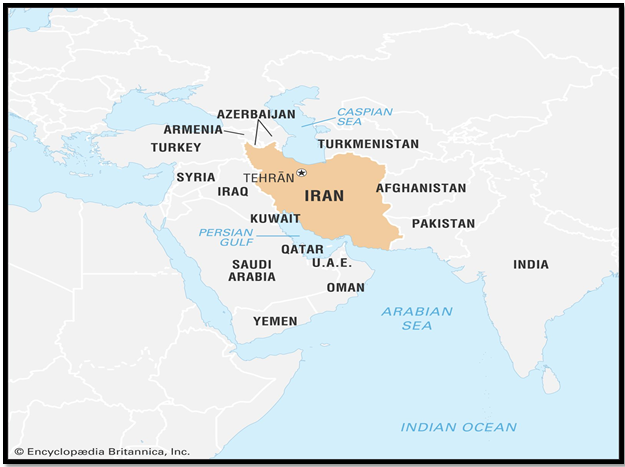RECASTING THE BATTLE WITHIN
Syllabus:
GS 2:
- India and its Neighbourhood- Relations.
- Effect of Policies and Politics of Developed and Developing Countries on India’s interests, Indian Diaspora.
Why in the News?
The sudden death of Iranian President Ebrahim Raisi in a helicopter crash has sparked significant political and regional implications, raising questions about succession, stability, and foreign influence in Iran’s turbulent political landscape.
Source: Britanica
Death of President Ebrahim Raisi
- Incident Overview: Iranian authorities confirmed the death of President Ebrahim Raisi in a helicopter crash on May 19 near the Azerbaijan border.
- Cause of Crash: Raisi was traveling to Tabriz after inaugurating the Qiz Qalasi dam with Azerbaijan President Ilham Aliyev.
- Travel Conditions: The presidential convoy consisted of three helicopters flying through bad weather; only Raisi’s helicopter crashed.
- Interim President: Supreme Leader Ayatollah Ali Khamenei quickly appointed First Vice-President Mohammad Mokber as interim president.
- Stability Message: Khamenei’s swift action aims to reassure both the Iranian public and the international community of Iran’s governmental stability.
Speculations and Enquiry
- Enquiry Commission: An investigation into the crash is expected, although there is already popular speculation about possible foul play.
- Foreign Involvement: Speculation includes potential involvement of foreign adversaries, although no official accusations have been made.
- Israeli Denial: Israeli media has reported denials from its government regarding any involvement in the crash.
- Regional Tensions: The crash could complicate regional tensions, especially with ongoing conflicts involving Israel.
- Domestic Compulsions: Iranian authorities might leverage the incident domestically if political pressures demand it.
Position of the Iranian President
- Supreme Leader’s Authority: The ultimate authority in Iran is the Supreme Leader, not the president.
- Election Process: The president is elected by the people but only from candidates approved by the Guardian Council.
- Limited Powers: The president’s powers are limited by the Supreme Leader’s decisive veto.
- Historical Context: Since the Islamic Revolution, only two clerics have held the presidency, indicating the position’s nuanced influence.
- Pragmatists vs. Hardliners: The political landscape often oscillates between pragmatists and hardliners, influenced by the Supreme Leader’s preferences.
| Status of Economic Ties Between India and Iran
Status:
Revival:
|
Hardliners and Pragmatists
- Hardliner Dominance: Hardliners have gradually overshadowed pragmatists, especially after the U.S. withdrawal from the nuclear deal.
- Policy Stances: Hardliners maintain a strict stance on gender issues and advocate for assertive regional policies.
- Judicial Background: Raisi’s background in the judiciary and his harsh sentencing made him the hardliners’ choice for president.
- Succession Speculations: There were speculations that Raisi might succeed Khamenei, but some believe Khamenei’s son, Mojtaba, could be a strong candidate.
- Guardianship and Continuity: The Revolutionary Guard, aligned with hardliner ideologies, supports maintaining revolutionary ideals and continuity in leadership.
Implications of Raisi’s Death
- Election within 50 Days: A new president must be elected within 50 days, as per the Iranian constitution.
- Guardian Council’s Role: It is unlikely that the Guardian Council will permit a pragmatist candidate to win the presidency.
- Revolutionary Guard’s Influence: The Revolutionary Guard will favor a hardliner candidate to ensure continuity of their policies.
- Unexpected Candidates: Historically, unexpected candidates have emerged in Iranian elections, and this trend may continue.
- Continuing Alliances: Iran’s alignment with Russia and China, especially post-U.S. nuclear deal withdrawal, is expected to persist despite Raisi’s death.
Regional and Global Dynamics
- Western Sanctions: Iran continues to struggle under Western sanctions, influencing its international alliances.
- Missile Attack on Israel: Iran recently retaliated against Israeli attacks, showing ongoing regional tensions.
- Controlled Escalation: Both Iran and Israel aim to avoid full-scale war despite their enmity.
- Biden Administration’s Role: The Biden administration, along with China, will likely work to restrain both sides.
- South Asian Policy: Iran’s support for India, particularly on the Chabahar port project, is expected to remain stable.
Domestic Political Stability
- Balancing Act: Iran’s recent engagements with Pakistan indicate a balanced South Asian policy that the new president will likely continue.
- Arab Relations: Despite rapprochement with Saudi Arabia, traditional tensions with Arab states will persist.
- Supreme Leader’s Future: The real test will come when a vacancy arises in the Supreme Leader’s office, potentially reshaping Iran’s political landscape.
- Pragmatists’ Decline: The influence of pragmatists has waned, but future political shifts could alter this dynamic.
- Domestic Focus: Iran’s internal political stability remains crucial, with leadership transitions closely watched both domestically and internationally.
Possible Consequences :
- Political Uncertainty: Raisi’s death creates immediate uncertainty within Iran’s political landscape, potentially destabilizing governance.
- Hardliner Dominance: Hardliners may further consolidate power, reducing the chances for pragmatists to influence policy.
- Succession Struggles: The process to elect a new president might intensify factional struggles between hardliners and pragmatists.
- Impact on Nuclear Talks: Ongoing or future negotiations regarding Iran’s nuclear program could be affected, with hardliners likely taking a tougher stance.
- Regional Tensions: Increased speculation about foreign involvement in the crash might escalate tensions with Israel and other regional adversaries.
- Internal Security Measures: The government may increase internal security and surveillance to prevent unrest and maintain control.
- Economic Stability: Uncertainty and potential instability could negatively impact Iran’s already struggling economy.
Conclusion
Raisi’s death intensifies the internal power struggle in Iran, with hardliners likely solidifying control. The event underscores the complex interplay of domestic politics and regional dynamics, impacting Iran’s future direction and international relations.
Source:Indian Express
Mains Practice Question:
Discuss the potential political and geopolitical consequences of the sudden death of a national leader in a volatile region, using the case of Iranian President Ebrahim Raisi as an example. How might such an event influence domestic stability, regional relations, and international diplomacy?




